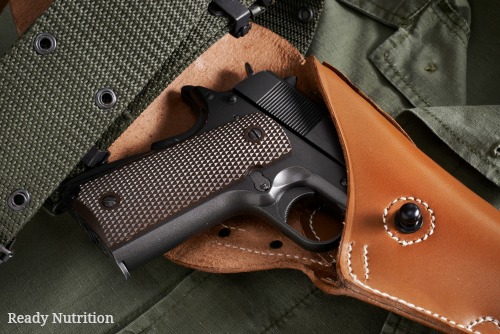
(Sign up for our FREE newsletter to get the latest prepping advice, gardening secrets, homesteading tips and more delivered straight to your inbox!)
I am not worried about the guy with the $3,000.00 rig…holster, weapon, and laser-sight with state-of-the-art attachments in a brand-new crisp outfit without a speck of dust and the ICP (International Combat Pistol)/NRA certification. I worry about the man with a worn holster and a weapon with the bluing rubbed off with a determined look in his eye. This man has used the weapon and has trained with it. The other guy can be a threat and (if approaching you) may be considered as such, but in all likelihood, he’s probably a Cabela’s model or a firearms salesman.
Why You Need to Train
Draw drills are a way of training your hands and eyes to be coordinated and act in one fluid movement. I do not ascribe to any philosophy of not aiming your weapon, or one of just “pointing it in a general direction.” The first time you have a target shooting back at you, you will realize just how important it is to aim at your target and hit it accurately and effectively. Paper targets don’t shoot back, so you have leeway with them. All the certifications in the world are no substitute for the basic fundamentals of marksmanship and the ability to employ them.
The objective of marksmanship: clean, well-placed shots. Anyone who served will tell you this and the importance of the fundamentals: aiming, breathing, and (proper) trigger squeeze.
Draw drills will help you to focus your point of aim, your proper hand positioning, and the fluid dynamics of drawing, aiming, firing, and reloading/changing your magazines. First, take some index cards, and mark them with a magic marker, 1 through 10. Laminate them. When this is done, they won’t wear down or become grimy with use. A few pieces of duct tape on each one, folded/rolled in on itself will allow them to affix. Then place them about the room you intend to train in.
You will then practice drawing your weapon from your holster, taking a proper stance and grip (modified Weaver, etc.) and then aligning your weapon on that numbered, laminated “paster” target. Use your imagination. You can place them on anything: lamps, closet doors, pieces of furniture. You can set them low or high. You don’t have to go in order of 1 to 10. In order to keep from being repetitive, go “even”, then “odd” numbers.
Magazine Changes
Next, you have to simulate changing your magazines. If you fire (just for example) a 1911 model .45 ACP, you’ll (generally) have a seven-round magazine. This means that after engaging target number “7” you’ll have to drop the mag, and reload another one. Obviously, you’re not firing rounds: but after each “draw” upon a target…reholster the weapon and draw on the subsequent number. Do a minimum of 100 of these per day. Your hand and eye coordination will improve, as well as your “muscle memory” of movements you’ll need for firing and also to change mags/speed loaders.
You need to be able to do these tasks regarding mag changes:
- Don’t take your eyes off the next target…you have to simulate that it’s a “real” one and can “gank” you if you let it.
- Drop that mag in your palm and place it (the “empty”) in a cargo pocket [Note: I hate these Hollywood movies that show everyone dropping the mags on the ground and just forgetting about them or abandoning them completely… don’t you do it!]
- Take the new mag from your pouch/belt, and seat it in the magazine well without ever looking at it. Simulate loading a fresh round, and engage your target.
- If you are doing a 1 through 10 series, at the end of it? With a 7-round magazine, you will then have 4 rounds left…you must keep track of how many rounds you’ve fired! This is as real-life as it gets in terms of training.
How you train in peace is how you’ll fight in war.
Keep a record of your training. You can (with time) substitute actual pictures/photos in place of your numbered targets. You want to move fluidly: with fluid dynamics, and being able to carry out your actions without needing to take your eyes off your targets. There are more advanced ways to draw drill that we’ll cover in future articles, but this one will get you started.
JJ
